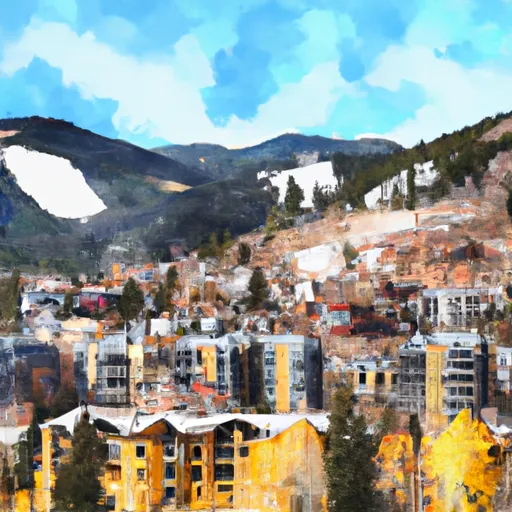-
 Snoflo Premium
Snoflo Premium
Get unlimited access to all our content
With no Ad interruptions! - Start Your Free Trial Login with existing account
Vail
Eden Index
Climate
6.1
•
Recreation
8.6
•
Community
1.5
•
Safeguard
5.8/10

Vail, Colorado is a picturesque mountain town located in the heart of the Rocky Mountains. Known for its world-class skiing and stunning natural beauty, Vail offers a unique blend of outdoor adventure and a vibrant community.
The climate in Vail is considered high alpine, with cool summers and cold winters. Average summer temperatures range from 50°F to 75°F (10°C to 24°C), while winter temperatures often drop below freezing, with frequent snowfall. This makes Vail a premier destination for winter sports enthusiasts.
Vail is surrounded by pristine rivers and streams that contribute to its hydrology. The Eagle River, which flows through the valley, provides ample opportunities for fishing, kayaking, and rafting. Additionally, Vail is home to Gore Creek, a renowned fly fishing destination known for its crystal-clear waters and healthy trout population.
Outdoor recreation is a major highlight of Vail, offering numerous activities year-round. In addition to skiing and snowboarding in the winter, visitors can enjoy hiking, mountain biking, golfing, and horseback riding during the summer months. Vail also boasts a diverse range of wildlife, including elk, deer, and various bird species, making it a popular destination for wildlife enthusiasts and photographers.
What is the Eden Index?
The Snoflo Eden Index serves as a comprehensive rating system for regions, evaluating their desirability through a holistic assessment of climate health, outdoor recreation opportunities, and natural disaster risk, acknowledging the profound impact of these factors on livability and well-being.
Climate Health Indicator (CHI): 6.1
Vail receives approximately
634mm of rain per year,
with humidity levels near 56%
and air temperatures averaging around
3°C.
Vail has a plant hardyness factor of
4, meaning
plants and agriculture in this region thrive during a short period during spring and early summer. Most
plants will die off during the colder winter months.
By considering the ideal temperature range, reliable water supplies, clean air, and stable seasonal rain or snowpacks, the Climate Health Indicator (CHI) underscores the significance of a healthy climate as the foundation for quality living.
A healthy climate is paramount for ensuring a high quality of life and livability in a region, fostering both physical well-being and environmental harmony. This can be characterized by ideal temperatures, reliable access to water supplies, clean air, and consistent seasonal rain or snowpacks.
Weather Forecast
Streamflow Conditions
Colorado Headwaters
Area Rivers
Colorado Headwaters
Snowpack Depths
Colorado Headwaters
Reservoir Storage Capacity
Colorado Headwaters
Groundwater Levels
Recreational Opportunity Index (ROI): 8.6
The Recreational Opportunity Index (ROI) recognizes the value of outdoor recreational options, such as parks, hiking trails, camping sites, and fishing spots, while acknowledging that climate plays a pivotal role in ensuring the comfort and consistency of these experiences.
Access to outdoor recreational opportunities, encompassing activities such as parks, hiking, camping, and fishing, is crucial for overall well-being, and the climate plays a pivotal role in enabling and enhancing these experiences, ensuring that individuals can engage in nature-based activities comfortably and consistently.
Camping Areas
| Campground | Campsites | Reservations | Toilets | Showers | Elevation |
|---|---|---|---|---|---|
| Parry Peak | 26 | 9,430 ft | |||
| Twin Peaks | 37 | 9,615 ft | |||
| Dexter | 24 | 9,271 ft | |||
| Matchless | 17 | 9,903 ft | |||
| White Star | 66 | 9,256 ft | |||
| Elbert Creek | 17 | 10,095 ft | |||
| Halfmoon West | 16 | 9,932 ft | |||
| Lakeview - Twin Lakes | 27 | 9,511 ft | |||
| Dinner Station | 22 | 9,613 ft | |||
| Halfmoon East | 6 | 9,923 ft |
Nearby Ski Areas
Catastrophe Safeguard Index (CSI):
The Catastrophe Safeguard Index (CSI) recognizes that natural disaster risk, encompassing floods, fires, hurricanes, and tornadoes, can drastically affect safety and the overall appeal of an area.
The level of natural disaster risk in a region significantly affects safety and the overall livability, with climate change amplifying these risks by potentially increasing the frequency and intensity of events like floods, fires, hurricanes, and tornadoes, thereby posing substantial challenges to community resilience and well-being.
Community Resilience Indicator (CRI): 1.5
The Community Resilience Indicator (CRI) recognizes that education, healthcare, and socioeconomics are crucial to the well-being of a region. The CRI acknowledges the profound impact of these elements on residents' overall quality of life. By evaluating educational resources, healthcare accessibility, and economic inclusivity, the index captures the essential aspects that contribute to a thriving community, fostering resident satisfaction, equity, and social cohesion.

